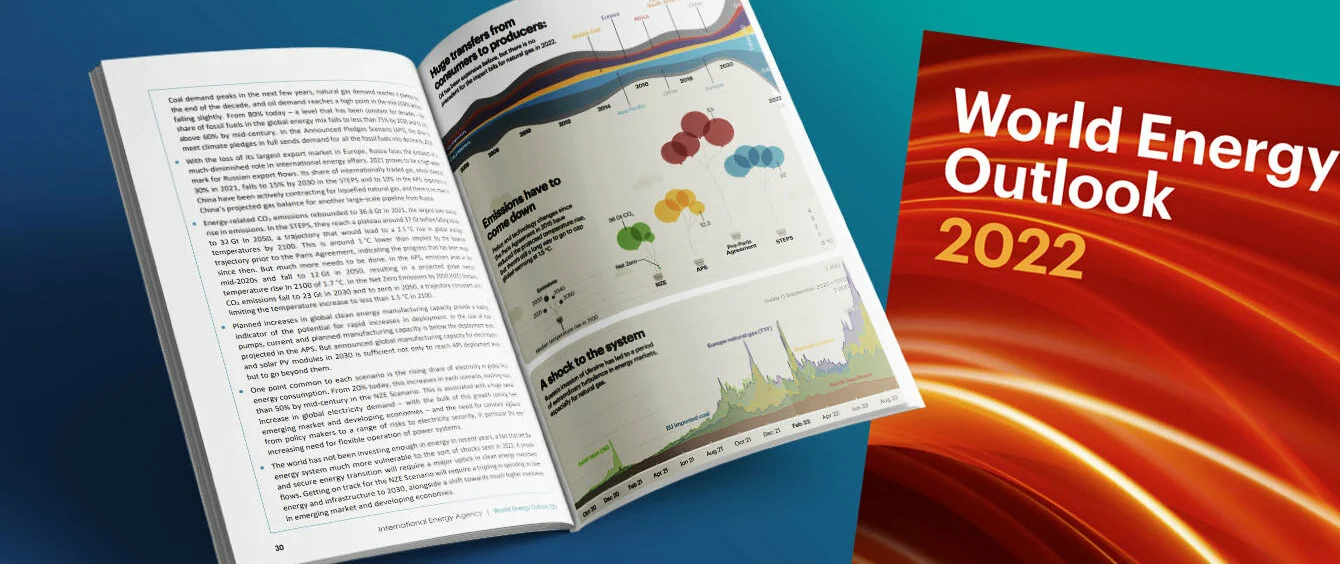The worldwide energy crisis triggered by the Russian attack on Ukraine is bringing in its wake fundamental and lasting changes around the globe. In the latest issue of the World Energy Outlook (WEO), the International Energy Agency (IEA) explores the ramifications of the war, reaching the conclusion that it has shocked the global energy system more than ever before. The authors state that, on the flip side, the negative consequences currently felt in many areas could accelerate the transition to a more sustainable and reliable energy system in the long run.
According to the IEA, this shock, which is primarily manifesting itself in massive price spikes for fossil energy sources, will make energy supply problematic above all in emerging and developing countries. Southeast Asia is mentioned in the WEO as an example of a region where gas prices doubled within the space of just a year. In addition, lower-income homes in industrial nations have suffered due to the dramatic increase in energy prices since Russia has started limiting gas deliveries, even discontinuing them entirely in certain cases.
Countries in which renewables already play a major role have much less difficulty in coping with the effects of tight supply and price increases. The IEA thus underscores that the crisis is not a renewables conundrum.
Crisis sparks surge in green investment
In the long run, the impact of the war could actually provide the key turning point in the transition to renewable energy. Some nations have already taken long-term measures such as the Inflation Reduction Act (USA) and the REPowerEU Plan (EU). These steps are designed to spur change and – more importantly – make green investment more attractive. Other programmes and legislation aim to increase or diversify oil and coal imports in order to circumvent the gas price explosion.
However, the IEA expects this fossil uptick to be short lived. The experts developed various cases in the WEO, including the Stated Policies Scenario (STEPS). They assume that over two billion US dollars will be spent on renewables in relation to global measures every year through to 2030 if they are fully implemented. This would represent an increase of more than 50 percent compared to the current level of expenditure.
CO2 emissions and demand for fossil fuel hit peak
For the first time, the IEA prognosticates CO2 emissions, and in turn global demand for fossil sources of energy, hitting an all-time high in 2025 in this scenario. The report has coal consumption dropping initially in the next few years, followed by a stagnation, which will also be experienced by gas (at the end of the decade) and oil (in the middle of the 2030s), after which these figures will taper off slightly at best. Therefore, overall demand for fossil fuel could experience a steady decline from 2025 to 2050.
Moreover, in the STEPS framework, the IEA anticipates the share of total energy accounted for by fossil fuel decreasing from just under 80 to just over 60 percent, with CO2 emissions declining to 32 billion metric tons from the peak of 37 billion metric tons (36.6 in 2021) during the same period. The authors believe this could drive up temperatures by 2.5 degrees Celsius by 2100, thus clearly missing the 1.5 degree target established by the Paris Agreement.
Expansion potential provides hope
Despite this, the 1.5 degree goal remains within reach, thanks to the high rate of renewable energy growth. If use of solar power, wind energy, electric vehicles, etc. continues to rise at present rates, the required transformation could occur faster than outlined in STEPS, the IEA claims. This is exemplified by photovoltaics: If build-out is rolled out as modelled in the Announced Pledges Scenario (APS) capacity would exceed that of STEPS by 75 percent by 2030.
However, this would require renewables trailblazers to provide substantial assistance to countries with less resources, in order to raise expansion to the necessary level in those nations. The IEA adds that current political measures will not suffice, requiring these actions to be stepped up as well. Based on IEA calculations, annual investment would have to be raised from two billion US dollars to a whopping four billion in order to hit the net zero target by 2050.
The authors state that, due to low prices, investment in the energy transition has been restrained in recent years, making the energy system much more susceptible to crises such as the one of 2022. Therefore, the energy transition calls for a substantial increase in green investment. In addition to environmental considerations, financial constraints could result in the transition being implemented in a sustainable manner.
